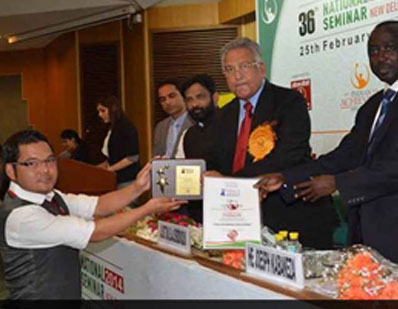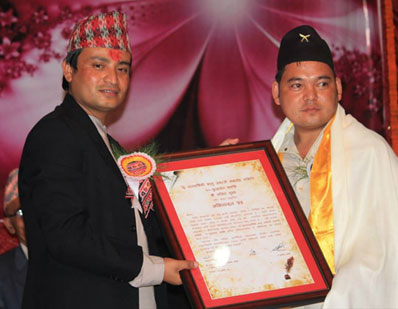Tourism is one of the mainstays of the mountain and hill economy and Sikkim is second to none in this regard. The mighty Khangchendzonga offer brilliant mountain scenery, healthier and invigorating climate. The snowy winter and cooler summer serve to invite many tourists to this tiny hilly state. Sikkim is a place where fusion of culture is distinctly visible. Sikkim has great beauty ranging from the mountains and multitude of rivers and lakes, which are considered as the sine-qua-non of Ecotourism. Sandwiched in the hills and mountain, Sikkim has now started gaining importance as a major ecotourist destination. It has everything which a tourist can dream of as a land of fairs and festivals, snow-clad mountains, holy lakes and peaks, religious centers, hot springs, trekking, water-rafting, pleasant valleys flora and fauna and so on.
Sikkim, one of the smallest state in the northeast India and the second smallest state in the country lies between 27.50 and 28.10 N and 88.40 and 88.580 east longitude. Spread across an area of just 7,096 sq. km, this state has a varied terrain climate and altitude resulting in a wide range of bio-diversity. Three foreign countries surround it ? Nepal in the West, Bhutan in the East and Tibet and China in the North and West Bengal in the South. Till the middle of 70?s Sikkim was under the monarchy government when the 35th Amendment Act made it an associate State of Indian Union and finally on 16th of May 1975 (38th Amendment Act), it was made a full-fledged state of India. Since then there has been a constant flow of tourist in Sikkim, which has played, great roles in boosting up the economy of the state.
Sikkim is a hilly state traversed by rivers and mountains that define its boundaries. Two principal mountain ranges- Singilela on the western border that marks its boundaries with Nepal and the Chola on the eastern border with Tibet. A low altitude range Pangolia marks the boundary between Sikkim and Bhutan. Most of the peaks above (20,000-ft) are on the western border of Sikkim (Khangchendzonga-28, 168 ft; Kabru-20, 000 ft; Sinolchu, Pandim, Simvo). Paunhri peak (22,000 ft) is the highest point on the eastern border of the State. Another mountain ridge separate Tista and Rangit valley, which include the peaks like Tendong (8660 ft), and Maenam (10,612 ft).
Glaciers are too many in Sikkim, important of which are the Zemu glaciers (largest in state), Rathong and Lonak glaciers. Mountain ranges are incomplete without passes, so numerous passes are found in the huge mountain range of Sikkim, the most important of which are- Nathu La (La meaning Pass) (14,140 ft), Jelep La (14,350 ft), Chiwabhanjang (10,300 ft).
Sikkim is gifted with a number of lakes, which are unexpected on such a rugged terrain. The serene lake Tsomgo lake (12,320 ft), Bidan Tso, Meimencho, Khechopari lake are the few to name. Gurudogmar Lake is the largest lake in the State located in the northern part of the state. Tista and Rangit are two important rivers of Sikkim, which gives off numerous tributaries along its course. Starting from a height of 18,000 ft, Tista travels down in 100 km to a height of just 3000-ft. These rivers never dry out, even in the winter as they are fed both by snowmelt as well as rains. There are numerous hot springs in Sikkim, which have medicinal as well as therapeutic value. Phurchachu, Yumthang, Yumey Samdong, Ralang are the important hot springs of Sikkim which are rich in Sulphur content and have an average temperature of 500 C.
The climate of Sikkim ranges from the tropical to alpine. Places with an altitude of 19,900 ft and above are snowbound and places as low as 9,850 ft come within the snowline in the winter. The temperature in the lower altitudes fluctuates between 40-350C and places with moderate height like Gangtok faces temperature between 10-250C. In the high altitude area (above 13,100 ft), the mercury never rise above 150C and slides down below the freezing point in winter. Because of its close proximity to Bay of Bengal and the obstruction of the path of monsoon clouds by mountains, most of the part of the state receives heavy rainfall throughout the year. It is only during the month of October ?March that the State remains drier.
Sikkim is one of the hottest tourist destinations in India. What oil is to Arab, tourism is for Sikkim. Ecotourism as we know form the definition given by TIES is responsible travel to natural areas that conserve the environment and sustain the well being of local people.
Medicinal Herbs to Vitalize State Progress. Agriculture accounts for a third of Sikkim?s Gross Domestic Product. More than 64 percent of the population depends on agriculture for livelihood.
Realising the importance of agriculture, the SDF government decided to adopt the policy of growth with sustainability. To diversify the plan, Department of Horticulture was given more importance as a means to aid development of horticultural crops- black cardamom, ginger, potato, orange, vegetables and ginger? s. The latest thrust, however, is on planting medicinal herbs, which abound the natural vegetation. The Sikkim Himalaya is extremely rich in medicinal wealth rich in medicinal wealth as associated with the Ayurvedic, Homeopathic, Siddah, Amchi and Unani systems of medicines. The state is reported to have more than 424 species of the medicinal plants.
With the development of medicinal plants in the state in mind, the state government formulated a State Medicinal Plants Board (SMPB). The chief Minister as its chairman, this Board mainly assesses the demand and supply of the herbs, formulates programs, identifies and regulates quantities of plants, promotes cultivation and collection through cooperatives and look into matters relating to import and export of raw materials. It also undertakes scientific research and encourages the protection of patent rights.
The SMPB proposes to fund 13 herbal gardens in the state. Contractual farming will be encouraged. Varying altitude and the climatic conditions are subject to regular change. Erratic rainfall and uneven distribution of rain is not uncommon. In general, temperature drops to 00C during winter and touches 300C in summer. The relative humidity is more than 70 percent in most places; on an average, the state receives 2,000mm to 5,000mm rainfalls per annum.
Despite the many constraints and problems associated with the agricultural development, the Department of Agriculture has taken measures to ensure a prolific output. Based on the average of five year (1995-2000) Sikkim recorded production of 97,228 tonnes with average yield of 1,353 kg per hectare for cereals.
Cereals grown include rice, wheat, maize, finger millet, barley and buckwheat, pulses like ricebean, rajmah, fieldpea, cowpea and clusterbean and oilseeds like rapseed, mustard, soybean and sunflower.The state government has laid a lot of emphasis on gearing up transfer of technology programs, including farmer?s training and demonstrations. For this, the Department of Agriculture offers training course in agriculture at Bidhan Chandra Krishi Vishwavidyalaya at Kalyani, near Kolkata. At least one farmers training program has been conducted in the model villages.
Emerging areas like genetic engineering, bio-insecticides, integrated nutrient management, integrated pest management and agri-business management are being incorporated. Horticulture being an important component of agriculture, the government has taken to increase the production and enhance the quality of the fruits and flowers.
Different program have been taken up fort the development of quality oranges, apples, passion fruits, pears litchi, vegetable like chilies, cabbage, cauliflower and spices like cardamom and ginger.
Floriculture has been taken up as an important component with flower cultivation being seen as a major employment generator fort the educated unemployed youth in the state. The state has taken several steps to facilitate production of good quality orchids carnation gerbera and Zanthadesia.
















 Anirudha Paul
Anirudha Paul



